After investigating the most popular variable among resistance training like how much one can lift, how often, and how many times, the study found that whether you use heavy or light weights, lifting them as many times as you can is enough to build strength and muscle. The authors report that the specific details of weightlifting do not matter as much as making the practice a regular habit, finding that all forms of resistance training are beneficial, including bodyweight exercises such as push-ups, planks, and lunges.
“There are a dizzying number of factors and combinations to consider when creating a weightlifting program to maximize strength and muscle growth,” says Stuart Phillips, a Kinesiology professor who conducted the work with graduate students Bradley Currier and Jonathan Mcleod. “This is an age-old debate among athletes and strength and conditioning coaches: what combination leads to the best gains?”
For this study, 192 randomized and controlled studies were reviewed with a total sample size of 5,000 people, making this project one of the largest of its kind to date. The authors report that this work is the culmination of years of planning, collecting, and analyzing data revolving around 3 resistance training variables: higher vs lower loads, single vs multiple sets, and training frequency, as well as whether one, two, or three (or more) session per week.
Most experts believe that using the heaviest weight which can typically only be lifted 3-5 times work best for building strength and that using weights that can be lifted 8-10 times works best for building muscle. However, the team at McMaster University have spent over the last decade pushing against that idea and they have published several papers prior to this one demonstrating that significant gains are possible using lighter weights toward the point of exhaustion which can mean 20-30 repetitions or sometimes more.
This comprehensive review from across the field found that lifting heavier weights is most effective to maximize muscle strength, but to maximize muscle size one should do each exercise several times with the weight being used being less important. This is good news for anyone regardless of age who might be interested in gaining strength and muscle maintenance, which are important to injury prevention, maximizing mobility, and optimizing metabolism.
“Our analysis shows that every resistance training prescription resulted in strength and muscle mass gains. Complex prescriptions are sufficient but unnecessary to gain strength and muscle. Simple programs are extremely effective, and the most important result is that people can benefit from any weightlifting program,” says Currier. “Seek guidance if you are unsure where to begin and how to progress, but it doesn’t need to be complicated.”
“The biggest variable to master is compliance,” said Mcleod, “Once you’ve got that down, then you can worry about all of the other subtle nuances, but our analysis clearly shows that many ostensibly important variables just aren’t that essential for the vast majority of people.”




